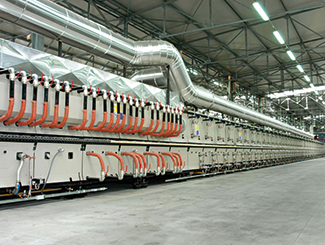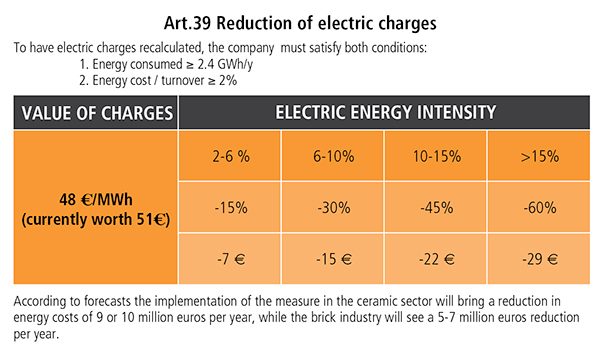 by Simone Ricci22
Dicembre
2014
by Simone Ricci22
Dicembre
2014
Energy-intensive businesses and the mess of electric charges
To restore competitiveness, additional costs have finally been reduced; but the actual implementation stumbles over unjustified bank guarantees.
Under the community directive for the taxation of energy products our country has had to adopt the new definition of “energy-intensive business”. The first application concerns the rescheduling of the criteria for burdensharing of general charges of the electricity system (tariff components A2, A3, A4, A5, AS). “Energy-intensive business” means a company that has used for its own activities at least 2.4 GWh electricity during the calendar year considered, having at the same time an electricity used costs/turnover ratio not lower than 2%. The great majority of ceramic and refractories manufacturers register an energy intensity index higher than 2% while only a limited part of the annual consumption threshold is not subject to tax reliefs.
To favour “energy-intensive businesses”, the Ministry of Economic Development has set a rescheduling of the parafiscal levies collected on electricity consumers’ bills which is more advantageous than the tax relief system currently almost entirely based on levels of consumption. In particular companies with an energy intensity index between 2% and 6% will see a 15% cut in tariff components (about 7 €/MWh) while for companies with an index between 6 and 10% reduction will be 30% (about 15 €/MWh).
Tax concessions have been applied retroactively starting July 1st 2013 and were supposed to be anticipated in March 2014 with a final balance adjustment in December. And that’s where things get stuck. The Italian regulatory Authority for energy has set up a guarantee system for the recognition of anticipations of concessions through Resolution no 148/14. To be able to claim money back, companies will have to provide a bank or insurance guarantee complying with the standard format issued by the Cassa Conguaglio Settore Elettrico (the Italian equilisation fund for the electric sector) and lasting two years. The guarantee has been submitted only by a third of those entitled to tax reliefs.
As to the modalities of claiming back 2013 final balance adjustments the Authority has stated that they should also be subject to the guarantee system. The Authority believes that until the European Commission has verified the compatibility of Italian legal provisions with the Community’s guidelines on State Aid (procedure in force since April 17th), payments should be made only against a bank guarantee so that any obligation to give money back is guaranteed.
Furthermore, the Authority has stated the guarantee system may also be used for the anticipation on the 2014 expertise benefit in case hte European issue remains unsolved. Confindustria Ceramica strongly criticizes the implementation modalities introduced and the unreasonable length of the guarantees required, calling for the urgency, in a moment when companies lack liquidity, to modify the process.
The Ministry of Economic Development also intervened informing the Authority for energy that the new European guidelines on State aid, which allow member States to have relief measures for energy-intensive businesses, bank guarantees are no longer necessary.
The issue remains open. But companies can no longer bear costly and pointless time-consuming bureaucracy.
